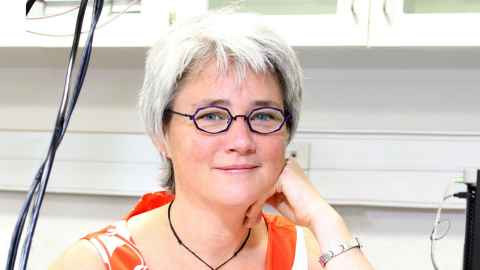Take 10 with... Frédérique Vanholsbeeck
Associate Professor Frédérique Vanholsbeeck from the Department of Physics gives us 10 minutes of her time to discuss her research in biophotonics and the two techniques she uses: spectroscopic fluorescence and optical coherence tomography.

1. Describe your research
Biomedical optics is the use of light to probe physiological and biological processes. I focus on two particular techniques. The first one is spectroscopic fluorescence, which I use to monitor bacterial processes applied to food safety. The second one is optical coherence tomography, an imaging technique, that I develop to detect early signs of non-communicable diseases like age related macular disease (AMD) or osteoarthritis.
2. Now describe it in everyday terms!
I shine light at biological samples and then analyse the light that is coming back to get as much information as possible about that particular sample. Currently, my samples are eyes, cartilages, the brain, bacteria, meat and berries. I am interested in subtle changes to detect, for example, the early onset of diseases when a cure is still possible, to understand how bacteria behave when you try to kill them or to improve horticulture sustainability. I work with collaborators from the primary industries and the biomedical sectors.
3. Describe some of your day-to-day research activities
Reading, writing, proofreading, meeting and – what I prefer – being in the lab, which does not happen often enough. Unfortunately, I spend too much time in meetings but I do enjoy the research discussions when we spend time - sometimes hours - looking at data or images to figure out what we can get out of it and if there is anything to understand better.
4. What do you enjoy most about your research
The interactions with students and other researchers. Also, discovering new applications for our imaging systems. Finally, being in the lab - tweaking our actual experiments.
5. Tell us something that has surprised you in the course of your research.
How much we lose in translation between research fields. Most of us have a very precise vocabulary and specialise in a very small field. There is not enough interaction between researchers from different backgrounds, and I find this is where the discoveries are the most challenging and rewarding. It is also a huge opportunity to learn. I spent my last sabbatical in a dermatology department, working on their images. It is amazing how much we learnt from each other.
6. What questions have emerged as a result?
How do I communicate what my research is about to people working in other fields and who could benefit from my imaging systems? Only then can interesting discussions begin and I can work with others on new projects and applications. This is how I end up working with so many different types of samples - each time there is something new to learn.
7. How have you approached any challenges you’ve faced in your research?
Perseverance and talking it through. Results do not come easily and can sometimes be surprising. You sometimes hear of scientific fraud and I think that it is because experimental results don’t always fit our expectations or model, and this is when exciting science actually begins ie. trying to understand results that are difficult to interpret. These challenging results are often the source of the best discoveries. Perseverance is also critical to obtain research funding, especially in New Zealand.
8. What kind of impact do you hope your research will have?
My big hope is to one day find a way to diagnose some important diseases earlier than with current methods, to allow for better outcomes with the treatments. A related goal of my research is to understand more about physiological and biological processes. More pragmatically, I really hope that people working with me enjoy their research and that they will also make a contribution. I also really hope to contribute to increasing the number of women in science.
9. If you collaborate across the faculty or University, who do you work with and how does it benefit your research?
I work and have worked with quite a few people across the University and the faculty like Cather Simpson (Faculty of Science), Cushla McGoverin (Faculty of Science), Simon Swift (FMHS), Ashvin Thambyah (Engineering), Ehsan Vaghefi (ABI and FHMS), Juliette Cheyne (FHMS) and many more. They are people who either help me to build my imaging systems or who need to apply them to specific tasks. It is always a very collaborative and fun process.
10. What one piece of advice would you give your younger, less experienced research self?
Do not start too many things at the same time. Try to stay focused, even if every single project that people mention to you is interesting. Do what I say, not what I do.